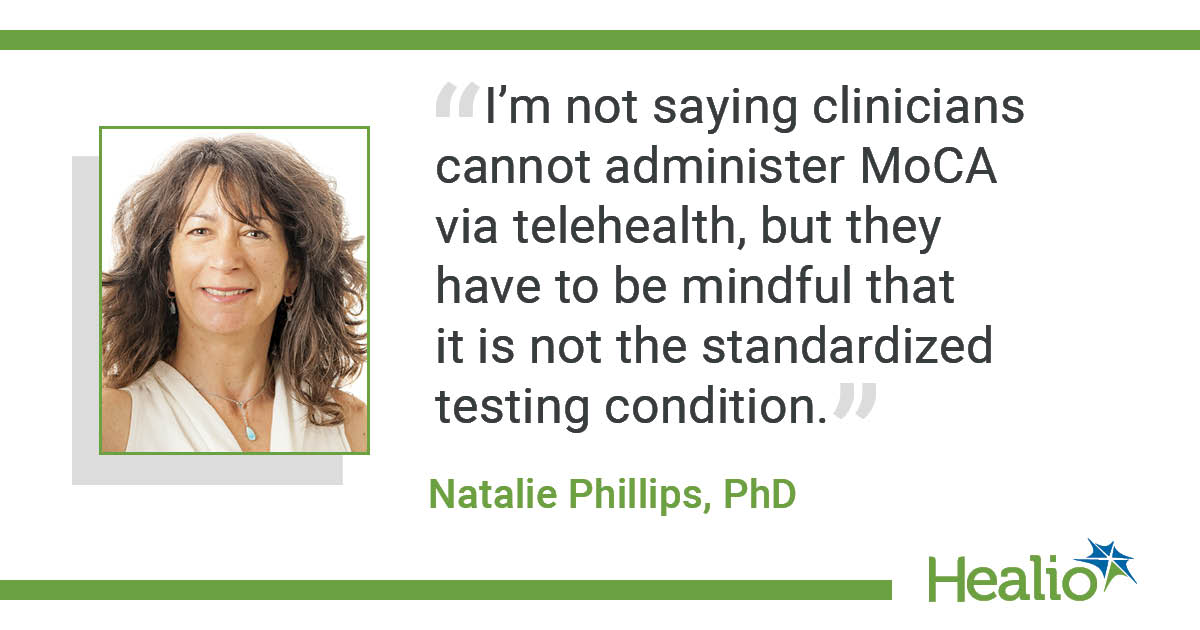Q&A: Conducting cognitive assessments via telehealth amid COVID-19
Administering the Montreal Cognitive Assessment, or MoCA, via telehealth poses challenges, one of the tool’s developers told Healio Primary Care.
“These are fundamentally non-standard testing conditions,” Natalie Phillips, PhD, professor of psychology at Concordia University in Montreal, said in an interview. “I’m not saying clinicians cannot administer MoCA via telehealth, but they have to be mindful that it is not the standardized testing condition.”

The MoCA is a screening tool that assesses cognitive functions that are sensitive to Alzheimer’s disease and mild cognitive impairment. With the COVID-19 pandemic prompting historic numbers of physicians to use telehealth, Phillips, who is also the associate scientific director of the Canadian Consortium for Neurodegeneration in Aging, discussed how physicians can adapt the MoCA for phone and video use, gauge the accuracy of these assessments’ results and more.
Q: How can physicians adapt the MoCA to telehealth?
A: Video conferencing would be the preferred way of administering the MoCA via telehealth because the patient can see the physician and the stimuli of the test. The physician also benefits because he or she can gauge the patient’s speech, establish rapport with the patient and facilitate the conversation. Physicians can also see if patients nod to signal that they understand, if they smile and if they are encouraging. All these nonspeech specific cues are very helpful in the MoCA assessment. The other obvious benefit to video conferencing is that the patient can see some of the test materials. But video conferencing also has disadvantages. The resolution of what the patient sees is going to be variable, based on whether the patient is using a desktop, full-screen computer, iPhones or an iPad.
When administering the MoCA over the telephone, you must eliminate all the assessment items that are visually presented. Our research has shown when visual items are excluded from the MoCA, it effectively eliminates the ability to test executive function, which fundamentally alters the test. In addition, cellphones often have poor audio resolution, putting older adults with hearing loss at a disadvantage.
Any decision the physician reaches must be based on sound clinical judgment, considering all the relevant knowledge of the patient.
Q: How can physicians get an understanding of a patient’s hearing and vision abilities via telehealth?
A: For hearing, physicians can ask something as simple as how the patient — with or without a hearing aid — would characterize their hearing (eg, excellent, very good, good, fair or poor). Ask if it is difficult for them to follow a conversation if there’s background noise, such as people talking, TV or radio or children playing. The physician should know what hearing assistive devices they are using.
Similarly, for vision, ask how they would characterize their eyesight, even if they use glasses or corrective lenses. Ask if besides glasses or contact lenses, are there any other aids or specialized equipment, and, if they do, what are they.
If the patient indicates that they do use assistive devices for hearing or vision, they must use them during the examination.
Q: How accurate can we expect overall MoCA scores, given variations in internet connections and computer abilities?
A: We have absolutely no idea. The proper studies have not been done. A 2013 study on the telephone version of the MoCA concluded the test is, understandably, limited in its ability to evaluate executive function and naming ability, which are based on visual stimuli in the face-to-face MoCA. Based on our research we know that when these items are eliminated, the sensitivity of the test suffers.
Q: What clinical decisions can be made based on assessments over telehealth?
A: Remember that cognitive assessments are a process, not necessarily an outcome. Clinicians can use the MoCA to elicit behaviors, make observations and/or help decide whether referral to a specialist is necessary. Administering the MoCA via telehealth also helps plan follow-up visits and determine if reassessment is necessary.
If the patient passes the MoCA via telehealth, one could be reasonably certain that they do not have any difficulties. If they fail, they could be failing due to their sensory health, anxiety, difficulties understanding the task instructions or lapses in attention. I would not use MoCA test scores administered via telehealth to make any legal decisions.
Q: Should patients be reassessed in the office after physical distancing measures are eased?
A: That is up to the physician. If a patient passes the MoCA via telehealth, the clinician can be fairly confident that was a true pass. But if the patient fails, then the question is, why did they fail? If it was a true fail, and not due to factors such as poor cellphone or video quality, having the patient come in for a fuller assessment under more amenable circumstances is very important. Now more than ever, the clinical observations, skill, and judgement of the clinician is paramount.
References:
- Al-Yawer F, et al. J Am Geriatr Soc. 2019;doi:10.1111/jgs.15940.
- Pendlebury ST, et al. Stroke. 2013;doi:10.1161/STROKEAHA.112.673384.
- Phillips NA, et al. J Am Geriatr Soc. 2020;doi:10.1111/jgs.16559.
- Wittich W, et al. J Vis Impair Blind. 2010;104:360-368.

